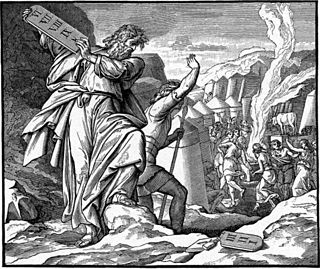[For articles on the “Sabbath of Ki Tissa" in Hebrew, click here]
The article is updated for 9/3/23Rabbi Dr. Yossi Feintuch was born in Afula and holds a Ph.D. in American history from Emory University in Atlanta. He taught American history at Ben-Gurion University.
Author of the book US Policy on Jerusalem (JCCO).
He now serves as rabbi at the Jewish Center in central Oregon. (JCCO).
This is the second of two articles on the sanctity of objects in Parshah 'Chi Tsha'. For the other article, click here (Hebrew):
* * *
What is the religious significance of Moses’ shattering the two tablets of stone upon seeing in his own eyes the abomination of the golden calf?
Moses seems to have imitated God in not passing premature judgment, even before he earnestly saw the pagan idol. Though God had broken to him the somber news about the idolatrous obscene happening in Israel’s camp, Moses did not hasten to break the tablets, that God had carved out, right there on the peak of Mt. Sinai.
Indeed, God had not rushed to take action against the people of Babylon upon “hearing” that they were building a tall tower and amassing themselves in one giant metropolitan; in so doing they were defying God’s first charge to the first humans (and their descendants) to scatter about and live all over the planet. Rather, God had first to “look” closely the Babylon Tower, thus demonstrating that even God did not rely on hearsay before taking any punitive action.
That the alleged abuse to God’s specific word needed to be visually verified from up-close, rather than be confirmed by sound alone, even when God was the “overhearer” of that sound, became evident again when God “came down” to witness the moral decadence in Sodom and its environs.
Hence, it is only when Moses saw personally the golden calf and the pagan debauchery about it, that he shattered the tablets, as though to tell us that even though God carved out those two tablets, their (presumed) holiness left them when the Israelites, their would-be recipient(s), became unworthy of the covenant that totally forbade idolatry.
Even the “holy ground” on which Moses stood when God’s angel revealed itself to him in a bush that was not consumed by the fiery flames that engulfed it, was no longer holy once Moses’ extensive dialogue with God about his mission to Egypt ended and the angel vanished from Moses’ sight.
Thus, when Moses smashed, with no seeming compunction, the tablets that God had given him, he demonstrated that in the religion of the children of Israel, material objects may not retain their holiness even if they temporarily were held as sacred. Even the so called “holy land” of Israel is not holy because it can contract moral impurities due to the conduct of its Israelite inhabitants and become defiled.
[Picture: Moshe breaks the tablets of the covenant ... The owner of the rights in this photo was not located. Therefore, the use is made under section 27A of the Copyright Law. The main rights holder, please contact: yehezkeally@gmail.com]
Besides the holiness of the incorporeal God, God proclaimed only the Sabbath (or the seventh day) — a formless time — as permanently holy. Yet, God called no stones as “holy”; had God done that it would have been inconceivable for Moses to shatter the tablets.
And when Moses chiseled out the second tablets (God carved out the first set that Moses shattered), he placed their shards in the ark next to the new whole tablets. In so doing Moses sent us a message to respect and honor those we turn our eyes away from due to reasons such as their old age, socio-economic status, or frail body. Though they might seem to be like broken vessels to us, not unlike the fragments of the shattered tablets, they belong with the whole.
Moses must have seen those strewn smithereens, that he smashed, like persons or inanimate objects that are no longer valid or of effective use, whilst remembering their past importance, even if only lasting for a short duration. Gratitude and respect reach their utmost zenith when given to those who can no longer be of practical benefit to the one who shows them.
The fact that those second tablets had enigmatically disappeared more than 25 centuries ago at the demise of the First Temple (586 B.C.E), whilst the Second Temple functioned without them, attests to the veracity of the premise of this commentary; for these stones, like their “first edition” predecessors, were not holy, as a holiness like God’s or of the Sabbath day is perpetual and eternal; it belongs totally to the spiritual realm
![[Picture: What is the religious significance of Moses’ shattering the two tablets of stone upon seeing in his own eyes the abomination of the golden calf? Free Image - CC0 Creative Commons - Designed and Uploaded by wal_172619 to Pixabay]](https://www.xn--7dbl2a.com/wp-content/uploads/2022/02/משה-ועשרת-הדברות.jpg)

![[Picture: Bible Paintings / The People Around Mount Sinai / Painted by: Ahuva Klein (C). All rights reserved to Ahuva Klein for the work]](https://www.xn--7dbl2a.com/wp-content/uploads/2022/02/ציורי-תנך-העם-סביב-הר-סיני-אהובה.jpg)
![[Picture: only when Moses saw personally the golden calf and the pagan debauchery about it, that he shattered the tablets... (Watercolor circa 1896–1902 by James Tissot). The picture is a public domain]](https://www.xn--7dbl2a.com/wp-content/uploads/2019/02/משה-משבר-את-הלוחות.jpg)
![[Picture: Moshe breaks the tablets of the covenant ... The owner of the rights in this photo was not located. Therefore, the use is made under section 27A of the Copyright Law. The main rights holder, please contact: yehezkeally@gmail.com]](https://www.xn--7dbl2a.com/wp-content/uploads/2022/02/משה-שובר-את-לוחות-הברית.jpg)




